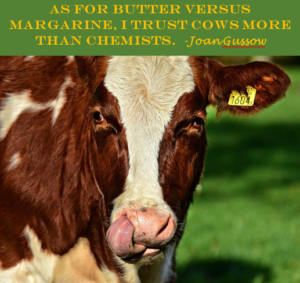 Ok, this is not an easy topic to write about without getting into the “science” of it, but I decided to give it a shot.
Ok, this is not an easy topic to write about without getting into the “science” of it, but I decided to give it a shot.
I was talking with someone recently who said that flies won’t even land on margarine. And that margarine was one ingredient away from being plastic. WHAT?!
Well, those statements fall within a somewhat controversial grey area. What I do know to be true is there was once a time when people churned their own butter, using just fresh or fermented cream or milk. That’s it! Somehow we have gone from that to where we are today, trying to decipher the numerous butter and margarine products and all of their confusing packaging labels. Part of the reason for where we are today is we hit the “butter is fat and fat is bad for you era” and margarine was created to be a butter-like product, designed to taste and look like butter (but without all of the saturated fat). Margarine was made primarily from vegetable oils, with added coloring, stabilizers, and preservatives.
So, we thought we were being healthier by using margarine instead of butter. But wait…not so fast! Because vegetable oils are unsaturated (liquid at room temperature), they were run through a process called hydrogenation to prolong shelf life and make them harder at room temperature. This process resulted in trans fats, which are now believed to be worse than saturated fats and which lower good cholesterol and increase bad cholesterol. Stick margarine typically has the highest levels of trans fat.
Fortunately, hydrogenation and trans fats have now been eliminated from many (but not all) margarine. But, of course, other chemical processes have taken its place (but that is another topic for another day).
So, where are we today? Basically, most butter is created from cream or milk whereas margarine is typically made from vegetable oils that are chemically extracted and refined. Butter’s ingredient list: cream and salt. Pretty simple, huh?!
Here is the ingredient list for “I Can’t Believe It’s Not Butter!”: Vegetable oil blend (soybean oil, palm oil, palm kernel oil, canola oil), water, sweet cream buttermilk, salt, mono and diglycerides, soy lecithin, natural and artificial flavor (milk), (Potassium Sorbate, Calcium Disodium EDTA) used to protect quality, Vitamin A Palmitate, Beta Carotene (color).
This doesn’t exactly follow the “don’t eat anything your grandmother wouldn’t recognize as food” rule.
Some butter has air whipped into it (making it lighter with less saturated fat). And, some butter now includes canola or olive oil, lowering saturated fat and making it easier to spread. While butter has a reputation of being loaded with saturated fat and contributing to heart disease (which some studies now question), it has some good qualities:
- Its taste can’t be copied…its melting point is at body temperature so it literally melts in your mouth…margarine can’t quite copy this.
- Adds richness to sweet and savory foods (you can add just 1 or 2 Tbsp to a recipe and it can give it great taste! Notice I didn’t say a whole stick!)
- Good source of vitamins A, D, E & K
- Won’t burn as easily as margarine
Don’t get me wrong, there are good reasons why someone might prefer margarine (for example, if you can’t eat dairy or prefer not to eat animal products). And, some of the newer margarines have low saturated fat and are free of trans fat – these are good things.
The bottom line?
- Everyone must choose what is best for them. We have chosen to use butter with the fewest number of ingredients – recognizable ingredients – in moderation!
- Use other alternatives whenever possible. You can use natural peanut butter, other nut butters, hummus or other spreads on your bread. Also, use olive oil or other healthy oils whenever possible!
- It is highly recommended to avoid anything with the words hydrogenated or partially hydrogenated…this means that trans fats are likely present.
There are times when butter can add a lot to a meal…like the Cod Vegetable Packet with Lemon and Dill (and parsley garlic butter) found on eatrealamerica.com! As always, just read the ingredient labels and don’t buy it if it has a bunch of unrecognizable ingredients!
 LEARN MORE ABOUT THE NAPKIN!
LEARN MORE ABOUT THE NAPKIN!
Leave A Comment